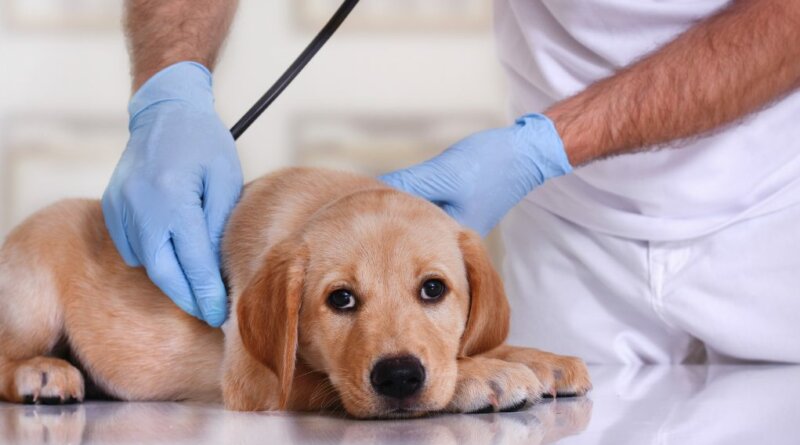Most Common Health Conditions in Dogs To Look Out For
Owning a dog is both a privilege and a responsibility. It’s a lifetime commitment that entails several duties, including keeping them from any common health condition.
However, several circumstances exist in a dog’s lifetime that put their health at risk.
Hence, it’s essential to be knowledgeable about the things that may affect your dog, especially the health risks that are prevalent to them. Here are the seven most common health conditions in dogs that you have to look out for.
7. Dog Worms
Dog worms are one of the most common health conditions in dogs. They are parasitic specimens that live in your pet’s organs, particularly in their stomach, intestines, and heart.
There are five common types of worms in dogs; roundworms, tapeworms, whipworms, and hookworms usually affect the intestines of dogs and cause diarrhea or fever, while heartworms affect the heart and cause breathing problems.
When your dog has become a victim of worm infestation, you must be vigilant and seek treatment.
Causes of Dog Worms
If your dog has roundworms, tapeworms, or whipworms, they have likely obtained them from accidentally swallowing an infected flea or ingesting infected feces.
Heartworms, on the other hand, are due to infected mosquito bites. And hookworms are obtained when a dog is grooming their feet after walking on soil contaminated with larvae.
In general, your dog will likely get the worms from accidentally ingesting an infected flea or larvae or being bitten by an infected insect.
Symptoms of Dog Worms
When dogs are suffering from worm infestation, they display obvious signs on their body. The symptoms primarily show on which organ they are affected most in their body.
- Change of appetite towards food, weight loss,
- Lethargy, weakness, and vomiting,
- Dulling of coat and hair fall,
- Potbelly appearance, or massive stomach due to bloating,
- Constant and chronic dry coughs,
- Bottom scratching; and
- Consecutively pooping due to diarrhea
If you’re suspecting that your dog has accumulated worms in their bodies, you can consult with its veterinarian. Also, have your pet thoroughly checked.
Dog Worm Prevention
To prevent any dog worms from afflicting your dog’s body, you may deworm them as early as three weeks old.
Aside from that, it is also highly suggested that you deworm a pregnant dog before she gives birth. Ask your veterinarian how to deworm them to avoid infecting her litter with her milk.
Since mosquitos and fleas are the leading causes of dog worms, ensure insect control all over your area. To prevent this, you must also clean up after your pet when they defecate or urinate.
Whether liquid, injected or swallowed in tablets, deworming medicine is often administered to your pet to eliminate their parasitic worms.
Consulting your veterinarian is essential in this type of situation. They will be the only ones who can determine the severity of the condition.
6. Rabies
Rabies is an incurable virus that affects most mammals, especially dogs. Another common health condition that may lead to a slow yet painful death to anyone afflicted mainly affects the brain and spinal cord by going through the victim’s bloodstream.
As soon as symptoms show, puppies will become very anxious and paranoid as the virus will cause psychosis.
When psychosis of your dog occurs, there may be sudden mood swings. They can be pleasant one moment and suddenly ready to attack the next.
Causes of Rabies
Mammals usually have rabies, and since the virus secretes through saliva; thus, dogs can acquire the rabies virus through bite wounds from an infected animal.
Rabies in dogs can pass from one to another, but they are prevalent in wild animals, such as raccoons, coyotes, and even bats.
The condition can be excruciating and slow for your affected pup, where they’ll experience seizures and paralysis before death.
Symptoms of Rabies
To indicate a possibly rabid animal around your area and may be infected with this sickness, determine from afar if they exhibit the following symptoms:
- Changes in behavior: restlessness, apprehension, aggression, or irritability
- Snapping or biting at any form of stimulus
- Attacking animals, humans, and even objects
- Licking, grinding, and chewing at the bite site
- Seizures
- Fever
- Paralysis
- Weakness
- Hypersensitivity
- Hiding in dark places
- Foaming at the mouth
- Disorientation, incoordination, and staggering
- Loss of appetite
- Sudden death
After seeing signs and symptoms of the rabies virus infection, immediately take your dog to the vet. Unfortunately, there is still no known cure for rabies.
Rabies Prevention
Anti-rabies vaccine shots can prevent rabies by receiving it annually. These shots may help in lessening the chance of fatality on your dogs.
You may also not want to let your dog go out a lot without your supervision. Please put them on a leash to prevent them from running away and encountering a rabid animal.
5. Canine Parvovirus
Parvo is another of these common health conditions. It’s a highly contagious virus that can spread from one dog to another by contacting infected feces.
This virus mainly attacks your dog’s stomach and small intestines. It may also affect the heart while destroying the lymphopoietic tissues, resulting in damaged blood cells.
Since puppies have a weaker immune system, they are suspected to be more susceptible to this disease. Humans are not affected but can be carriers of these viruses.
Causes of Parvo
Parvo transmission happens if a dog comes in contact with a contaminated object or feces. It’s typically done through dog-to-dog transmission as well.
The virus can live in the surroundings for months and may survive on objects such as food containers, floors, shoes, carpets, etc.
When dogs are unvaccinated, dogs can get parvovirus from the streets.
Symptoms of Parvo
When infected with this virus, notice these symptoms with your dogs and be on the alert with it:
- Bloody and watery diarrhea,
- Loss of appetite due to their ongoing digestive problem,
- Lethargy and lack of enthusiasm,
- Abdominal pain,
- Constant panting and breathing difficulties,
- Vomiting at random times of the day,
- Dehydration and refusal of drinking water,
- Continuous body pain
Typically, to identify the possibility of parvovirus infection, the vet usually uses blood sampling to identify an abnormality in white blood cells.
This diagnosis is essential mainly because aside from lymphopoietic tissues, parvovirus also attacks the bone marrow.
Parvovirus Prevention
Your dogs can prevent canine parvovirus using antibiotics, and vaccines can prevent the infection within their system.
Dogs must have a complete vaccination or when a dog gets older and has not received an entire puppy vaccination series, give them at least one immunization.
Parvovirus can live in the surroundings for months; take precautions if there has been an infected dog in your house. Parvo is resistant to many disinfectants and can be very difficult to control.
However, it is a preventable condition, seeing that you prevent your pet from coming in contact with potentially infected dogs.
4. Kennel Cough
Kennel cough is a common health condition caused by the bacteria Bordetella bronchiseptica that causes inflammation on your dog’s trachea and lungs.
This condition is contagious and may affect a large group of dogs.
Unvaccinated and younger dogs are more prone to Kennel Cough.
Causes of Kennel Cough
Although there’s no direct indication of how kennel cough begins in a dog, it usually spreads like a common cold.
Thus, upon contraction of the Bordetella virus, a dog can easily infect others around them through their food, drinks, or even toys they play with.
Symptoms of Kennel Cough
When a dog is suffering from Kennel cough, one of the primary symptoms they experience is coughing and gagging. However, it may also present other symptoms, such as:
- Runny nose due to their constant mucus secretion while coughing,
- Breathing difficulties due to constricted airways,
- Lethargy and weakness,
- Loss of appetite associated with their breathing difficulties; and
- Low-grade fever, which falls around 100.4 to 102.2 degrees Fahrenheit
When your dog has a cough, see your veterinarian make sure.
Kennel Cough Prevention
Fortunately, your dog may prevent kennel cough by administering the parainfluenza, adenovirus-2, and Bordetella vaccine, which may also be helpful in case of pneumonia.
It would be best if you ask your vet how often your dog should acquire these vaccines. However, bear in mind that vaccinations are not effective when your dog has already caught the virus.
Other than that, it’s best to keep your dogs away from other pups unless you’re sure that they’re kennel cough-free.
3. Urinary Tract Infection (UTI)
Urinary tract infection, also known as UTI, is an infection due to Escherichia coli (the bacteria found in feces) and affects your pet’s urethra.
This common health condition makes dogs sluggish and unable to pee well, and they might cry out because of excruciating pain.
These are usual infections in our pets due to their constant bowel rituals and sometimes due to contaminated environments.
Causes of UTI
UTI may be due to dehydration, diseases, and other conditions related to kidney and blood circulation.
Many bacteria can cause this common health infection, but the most common is Escherichia coli (the bacteria found in feces).
If a male dog is unneutered, the infection can also reach their prostate, which will be more painful.
Symptoms of UTI
If your pet frequents these actions, he may be experiencing this infection:
- Frequent attempts in urination with little success,
- Yellowish pee that may or may not contain blood,
- Abdominal pain due to difficulty in peeing; and
- Constant licking of genitals to soothe the pain they’re feeling
When diagnosing UTI, a veterinarian will likely ask for a urine sample of the afflicted pet.
However, the requirement for this is a sterile sample, so they’ll use a needle to collect urine from your pup’s bladder.
The only confirmation that ensures that they may have UTI is the abnormal presence of blood cells in their urine for the sterile sample.
UTI Prevention
Always make sure that there is a fresh and clean supply of water for your dog. Hydration is vital for your pet’s urinary system because it dilutes impurities for their blood circulation.
If it’s possible, let your dogs do their business outside.
Furthermore, it is also essential to watch your pet’s diet to prevent their UTI from occurring. In most cases, antibiotics will be the veterinarian’s prescription to kill the bacterial infection afflicting your dog’s urination.
2. Diabetes
Also known as Diabetes mellitus, sugar diabetes is the type of diabetes most frequent in canines. It is when the connection between glucose and insulin does not work like it usually does.
This condition is something that any animal, like dogs, cats, apes, and even humans, can experience at any time.
There are two types of diabetes:
1. Insulin-Deficient Diabetes
If your dog increases in size, skin thickness, and their laryngeal glands soften, it might be an indication that your dog’s insulin-deficient.
This disease may be due to the damage to their pancreas that regulates insulin. This type is the most common type of diabetes among dogs.
2. Insulin-Resistance Diabetes
Impairment of the immune system is likely to happen to dogs with an insulin-resistance type of diabetes.
This diabetes, on the other hand, creates enough insulin, but its body isn’t utilizing any of it. This typically happens with older, obese dogs.
Diabetes itself isn’t a curable disease, but it can be successfully managed, depending on its severity.
Causes of Diabetes
With the abnormality of insulin, expect either too high or low blood sugar levels, which may be life-threatening for your pup.
Genetics, autoimmune disease, obesity, and abnormal protein deposits in the pancreas can significantly develop the disease.
Obese dogs and female dogs have a greater risk of developing diabetes when they are 6-9 years of age.
Symptoms of Diabetes
Though symptoms may occur when they get older, the following symptoms have an attribute to diabetes.
- Polyuria is when your dogs urinate more than usual and in abnormally significant amounts,
- Polydipsia, or excessive dehydration and thirst, is one of the few early signs of diabetes,
- Polyphagia, or increased hunger and appetite for food even if they’ve already eaten,
- Slowly but progressive cataracts in your dog’s eyes, and
- Weakness and lethargy, which may lead to their disinterest they usually like
Your veterinarian will collect information to diagnose diabetes properly and perform a physical examination; they also need to check blood work and urinalysis.
Diabetes Prevention
Proper diet and regular exercise are the best-known prevention for diabetes may it be hereditary or due to age.
To prevent secondary problems like cataracts and severe urinary infections, consult a veterinarian immediately not to cause coma or death for the dog.
Every dog will respond differently to treatment; it may be due to how complex the situation is and the dog’s medical history as to whether another complication may arise.
The key to this common health condition is monitoring their blood sugar levels to manage diabetic pets successfully.
1. Cancer
Cancer is a deadly terminal condition in older dogs in which the cells in their body grow uncontrollably. These cells will eventually invade the surrounding tissues; thus, spreading it to other body areas.
Tumors of any kind are possible to grow in their bodies, and they can either be benign or malignant.
There is a 50% probability that dogs may acquire cancer as they age.
Causes of Cancer
Cancer, despite being a common health condition, has no single cause. It may be due to exposure to chemicals, pollution, or UV rays.
It can also be due to the vulnerability of the breed due to its heredity.
Symptoms of Cancer
Many possible symptoms of cancer include the following but are not limited to:
- Lumping or bumping of the skin,
- Wounds or bruises that won’t heal on their own,
- Abnormal bleeding on the affected areas,
- Change in appetite,
- Lethargy and sudden lameness,
- A strange odor from their ears, mouth, and bottoms,
- Breathing difficulties;
- Abdominal swelling; and
- Tumors
The canine must undergo a series of tests when determining cancer.
When there’s a lump present, your dog may undergo a needle biopsy, which removes a tiny tissue sample for microscopic examination of cells.
Blood evaluation, X Rays, Ultrasound, and other tests may also help determine if cancer cells are present or could have spread.
Cancer Prevention
Spaying and neutering your pet at a specific age help decrease the chances of cancer.
Furthermore, try to avoid products that may induce cancer in anyone and avoid carcinogens like cigarettes.
Though we cannot entirely prevent cancer from occurring, these are the best methods to contain specific and common cancers.
Cancer Treatments
Treatments vary based on the type of cancer that is afflicting your dog.
Surgeries like radiation, chemotherapy, a combination of both, or surgical treatment help lessen the cancer cells within their bodies.
If there is no hope, some pet owners go for no treatment at all. But one must consider opting for palliative end-of-life care.
Conclusion
Like humans, dogs are not immune to any rare or common health conditions they might experience in the future. Even though your dog has received a vaccination for a particular disease, they do not provide 100% immunity.
Thus, it’s essential to keep yourself updated on the latest dog health trend, especially with the diseases mentioned above. This practice will also help you be conscious of any underlying conditions that your pet might be experiencing.
Bear in mind that it’s your responsibility to keep your dog healthy and happy. Hence, you have to make sure that you are doing your part by getting the help and care your dogs need.
READ NEXT: 11 Most Deadly Dog Diseases
Related










